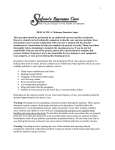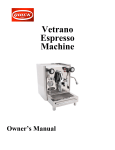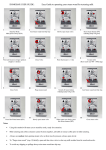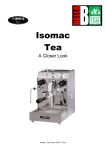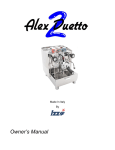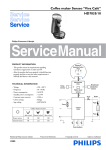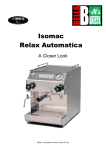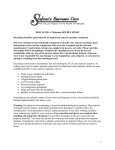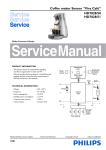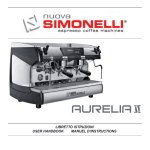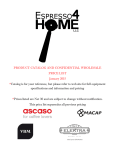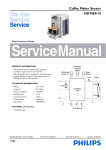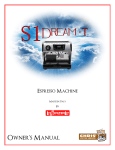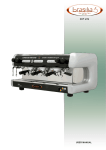Download Lollo manual instruction
Transcript
Lollo HX user’s guide Summary 1. Information regarding the use of the machine 5 2. General safety rules and warranty 6 3. Connect the machine 7 3.1. Connect to existing water lines and to drain system 3.2. Connect to power supply 3.3. Switch the machine ON 7 8 9 4. Brewing espresso 10 5. Grouphead washing cycle 12 4.1. Brewing espresso: lever version 4.2. Brewing espresso: electronic version 4.3. Brewing espresso: electronic version doses programming 4.2. Brewing espresso: electronic version 4.3. Brewing espresso: electronic version doses programming 10 10 11 12 12 6. Steam milk and puor hot water 13 6.1. increase/decrease pressure/temperature 14 7. Hints, Tips, and Tricks 15 7.1. Maximizing Steaming Power 7.2. Minimizing Temperature Variations During the Pull 7.3. Minimizing Mineral Buildup 2 15 15 16 8. Cleaning and Maintenance 8.1. After Each Pull 8.2. After each stratching milk 8.3. After Each Session 8.4. Backflushing 8.5. Cleaning the Portafilter and Filter Basket 8.6. Exterior Cleaning 8.7. Grouphead Gasket Replacement 8.8. Hot Water Wand and Steam Wand 8.9. Long Term Storage Waste disposal 17 17 18 18 20 21 21 22 22 23 27 3 4 1. Information regarding the use of the machine Carefully read the information into this book because there are important suggestions about security for people using the machine and for those who make servicing. The machine must be used only in the way and for the purpose it has been built for. This manual is considered an integral part of the machines. VIBIEMME cannot be considered responsible for any damage due to an incorrect use. • do not use the machine without water into the boiler • do not touch hot parts (hot water or steam pipes) • do not remove the filter holder during coffee delivery • do not leave the machine off if temperature is below zero • do not leave the filter holders hooked to the groups if the machine is not in use • regenerate the softener at scheduled periods The use of any kind of electric machine means the observance of the very simple following rules: • do not touch the machine with wet hands • do not use the machine barefoot • do not pull out the electric cable to disconnect the machine • do not let children or unauthorised personnel use the machine • do not replace cables or other parts of the machine • do not cover the top of the machine with a dish cloth 5 2. General safety rules and warranty Should any unauthorised modification be performed on the equipment or should the maintenance be defective and/or inadequate, the manufacturer is relieved from every liability for damages due to improper or wrong use of the equipment. Therefore warranty is cancelled in case of: • non-observance of the instructions contained in this handbook; • non-observance of the intended use, as per instructions; • failure to comply with the recommended maintenance schedule; • use of non-original spare parts during maintenance and repairs and/or when maintenance works are performed by unqualified personnel; • failure to comply with general measures for accident prevention and Industrial Medicine provisions VIBIEMME cannot be considered responsible for any damage due to an incorrect use. 6 3. Connect the machine 3.1. Connect to existing water lines and to drain system Check that the connections to the waterworks and the water outlets are complying with the current law provisions; make also sure that there are no obstructions affecting the water outflow. • Remove the Drip tray cover • Remove the Drip tray • Screw the Stainless Steel Hose to the 3/8 BSPT charge, and connect the other side of the pipe (3/8 BSPT) to your existing water line. • Connect the Drainage hose to the relevant cup provided under the Drip tray IMPORTANT: make sure the incoming pressure is not above 4 bar; if this happens, install a pressure reducer.: The right pressure to brew espresso is between 9 -9.5 bar: this is the bypass setting of motor-pump. If the incoming water pressure is more than the bypass pressure, the brewed water flux will hit the coffee grounds too violently, over-extracting it. Over-extraction will negatively influence the physical and chemical coffee values. 7 3.2. Connect to power supply The electrical feeding must be done through an automatic switch, suitable to the power of the machine (see the identification plate on the machine) and provided with thermic protection and fuses (this installation work must be carried out by skilled personnel only). Before connecting electrical supply be sure that AC mains and machine voltage are corresponding. If these standards are not followed VIBIEMME will not be held responsible for damages to things and/or persons. Connect the power cable to the previously installed main switch following the drawing below: 8 3.3. Switch the machine ON Switch the Power button ON : the orange light will turn on. The boiler water inlet and the element will automatically start; once the boiler is filled the Red Heating Element Activity Lamp is informing the element is worming up. Wait until the Red Heating Element Activity Lamp turns off, then check on Brew Pressure Gauge (right side of the machine) that boiler pressure is about 0,9 - 1,1 bar. In this phase it is necessary to open both the Steam Valves and let the air inside the boiler go out. IMPORTANT: the boiler water filling is protected by the time-out function (120 seconds), once this time is elapsed water filling automatically stops: touchpads leds start blinking. Then it is necessary to repeat all instructions from the beginning – SWITCH THE MACHINE ON – To use cup warmer switch the Cupwarmer button ON 9 4. Brewing espresso 4.1. Brewing espresso: semiautomatic version Press belonging to the reference group to start pouring coffee. The led corresponding to the pressed key lights up and remains on during all coffee dispensation. To stop coffee dispensation, press key 4.2. Brewing espresso: electronic version Press any of the four dose keys belonging to the group chosen for dispensation in order to start pouring coffee. The LED related to the chosen dose key remains ON until the coffee dispensation is completed. NOTE: the dosing allows to produce coffee at the same time from all the groups on the machine. Any dispensation in progress can be stopped by pressing any of the dose keys on the keyboard related to the operating group. 10 4.3. Brewing espresso: electronic version doses programming Each coffee dose’s quantity can be modified thanks to the volumetric control and can be memorized through the following procedure: 1) Press the key, keep it pressed for more than 5 seconds until the LED is on. 2) Press within 5 seconds (programming time-out) any of the keys related to the four programmable doses ; the LED of the pressed key remains on, as the one related to the programming function. 3) When the desired coffee quantity is reached, please press any of the coffee keys on the keyboard related to the group under programming to stop the dispensation. The new dose value is memorized. At the same time all LEDs related to doses switches ON and the programming LED starts blinking; it is now possible to go on programming the other doses without repeating the entering procedure (see point 1). - Repeat point 2) and 3) to program all other coffee doses (if the programming time-out hasn’t elapsed) - In case the time-out (5 seconds) intervenes on programming phase, please repeat points 1), 2) and 3) IMPORTANT: the programming performed on the 1st group is ALWAYS automatically transferred even on the other groups. Anyway this doesn’t affect the possibility of programming the other groups independently from the first one through the procedure described in points 1), 2) and 3). 11 5. Grouphead washing cycle 5.1. Grouphead washing cycle: electronic version The washing cycle allows the coffee groups’ cleaning and can be started as follows: press the key and then the first dose key 1LO both belonging to the group to be washed. Both LEDS are blinking during all washing process, unless one of the other keys of the group is pressed. During washing the LEDs on the touchpad are OFF (expect the two blinking LEDS mentioned above). 5.2. Grouphead washing cycle: semiautomatic version The washing cycle allows the groups cleaning and can be started as follows: press at the same time both and belonging to the group to be washed. When one of the other keys of the group is pressed during washing, all LEDs light up and the washing phase stops. During the washing phase both LEDs of the pressed keys are blinking ; all other LEDs are OFF. 12 6. Steam milk and puor hot water To produce steam acting on the Steam Valve. To pour water acting on the lever of the Hot Water Valve. For this first use of the machine, once the pressure is above about 0.5 you should flush the boiler to be sure that the machine is working properly. Place a suitable container (like a heat-resistant glass measuring cup or stainless steel steaming pitcher) under the hot water spout and carefully open the hot water valve. Water should pour out and the pump should start. Pump out about 6 ounces and then close the hot water valve. Repeat this two or three times over the next five or ten minutes, and then check the reservoir level. WARNING: The water dispensed as described above is hot enough to cause serious burns. Use caution whenever dispensing or disposing water. After an additional five or ten minutes of warm-up time, test the steam function. Place a vessel under the steam wand and slowly open the Steam Valve. Steam should come from the Steam Wand and the boiler pressure should drop slightly. After a few seconds, close the Steam Valve. It is normal for some water to spurt out of the Steam Wand when the Steam Valve is first opened after it has been closed for some time. WARNING: Steam can easily cause deep and nasty burns. The metal Steam Wand gets very hot. Always move the Steam Wand by holding the rubber sleeve and take great care whenever using the steam function. When using the Steam Wand, the pump may occasionally operate on its own. The steam comes off the top of the main boiler where it is “stored” all the time, and the pump will only run when the water level drops to a point determined by the depth of the water-level sensing wire. Now it’s time to wait! We mentioned in the other manual that patience is a virtue when it comes to making espresso and here is our first example. The boiler, that huge brass grouphead, the portafilter, and all the related metal parts need to come up to temperature. As the boiler comes up to temperature, hot water will circulate through the system, helping to speed things up, but plan on waiting about twenty or thirty minutes before the machine is ready for use. 13 6.1. increase/decrease pressure/temperature The pressurestat controls temperature (pressure) by sensing the pressure in the steam boiler. Accessing the pressurestat adjustment is simple. Simply remove the Cup Warming Tray and on the top back of the machine you can find the Pressostat ( Sirai black plastic box with a graduate +/- scale): fit a screwdriver, then turn to adjust the boiler temperature: CLOCKWISE LOWERS the TEMPERATURE/PRESSURE COUNTERCLOCKWISE RAISES the TEMPERATURE/ PRESSURE 14 7. Hints, Tips, and Tricks 7.1. Maximizing Steaming Power You probably have noticed that the heating element cycles on an off while the machine is in operation and even when it is idling. That can be seen by watching the Heating Element Activity Lamp on the control panel. That cycling can be used to your advantage when steaming milk. For the greatest production of steam throughout the steaming cycle, start steaming just before the heating element turns off. You can judge this by watching the Heating Element Activity Lamp in conjunction with the boiler pressure gauge. The goal is to begin steaming when the boiler is as hot as its range allows while the heating element is still energized. As you draw off steam the pressure in the boiler (and thus the temperature) will drop slightly which keeps the heating element energized. With a little practice you will be able to do this without hardly even thinking about it.. 7.2. Minimizing Temperature Variations During the Pull A similar procedure can be used for the brew cycle. The best time to begin pulling a shot is when the heating element has just turned off. This gives a bit more temperature stability as well because it eliminates the variable of the heating element coming on during the pull. If the heating element comes on during a pull, you will hear the pump lose a bit of power because the heating element is drawing a large percentage of the circuit’s available current. If the circuit that feeds electricity to your Vibiemme Domobar is challenged by the demands of the machine, this procedure will help lessen that load. 15 7.3. Minimizing Mineral Buildup Mineral buildup in the boiler can be minimized by using the proper quality water and by de-scaling as mentioned in the general instructions. Another way to lessen this scale accumulation is to pump water out of the boiler occasionally. This is particularly important if you rarely use the hot-water function of the Vibiemme Domobar. To refresh the water in the boiler, simply place a heat-resistant vessel under the hot water wand and open the valve. Dispense about 6 ounces, and then allow the boiler to refill before proceeding. Repeat this two or three times. Doing so every one or two weeks will help minimize scale build up. 16 8. Cleaning and Maintenance As with all fine tools, the Vibiemme espresso machines can give you years of trouble-free service and better performance if properly maintained. Your Vibiemme espresso machines does require a bit of care, but it is not at all difficult. Although the following guidelines will give you some idea of how often the tasks should be performed, there is no specific set of rules concerning the frequency of cleaning and maintenance. A machine that is being used to make two or three drinks each day in a home environment will not need to be cleaned quite as often as a machine used in an office or restaurant where it is called upon to make fifty drinks a day. If in doubt, it is better to do cleaning and maintenance chores a little too often rather than not often enough. 8.1. After Each Pull KNOCK PUCK After the pull the spent coffee puck in the Portafilter should be knocked out. The best way is to use a knock box. These feature a cushioned bar with a soft surface that protects the Portafilter from damage. QUICK FLUSH As soon as you remove the Portafilter from the Grouphead after a pull, cycle the brew function for about one second or so. This will help flush out any coffee on or behind the shower screen. FLUSH PORTAFILTER If you are not immediately going to pull another shot, replace the Portafilter and repeat the quick flush. Pushing a bit of clean water through the Portafilter will remove most of the left-over coffee in the Portafilter. Remove and wipe it off after the flush. If the machine is going to be left on, leave the Portafilter in place so that it can remain warm. 17 8.2. After each stratching milk The steam wand must be wiped off immediately after every use with a damp towel or dish rag after removing the wand from the milk. As soon as the wand is wiped, the steam valve should be briefly opened and closed to create a blast of steam to force out the remaining milk that may be in the wand. Allowing milk to sit on (or in) the wand will bake the milk onto the hot metal. This is not only unsanitary but can also become very difficult to remove. If you do have baked on milk we do not recommend soaking the wand in a pitcher. This can cause dirty water to be drawn into the wand, and under certain conditions, possibly into the boiler. WARNING: The Steam Wand can be very hot. Avoid touching the wand directly and use caution when wiping the Steam Wand. The heat can cause the water on the rag to turn to steam which can cause a burn. 8.3. After Each Session GROUPHEAD The area where the Portafilter locks into place gets exposed to a lot of coffee and must be kept clean. Coffee residue left here will not only degrade performance over time but can also detrimentally affect the taste of the coffee. At the end of each session, use the Grouphead Brush which was included with your Vibiemme espresso machine to clean the screen as well as to give the area in which the grouphead gasket resides a good scrubbing. PORTAFILTER At the end of each session, the Portafilter should be rinsed under hot, running water and dried off before storage. While it should be left in place on the Grouphead during use, if the machine is being turned off, the portafilter should be stored elsewhere so that the moisture can evaporate from the grouphead. Otherwise it can stagnate in there. DAILY BLIND FLUSH - At the end of each day (or when you are through using the machine for that day) you should do a blind flush: 1 - Remove a filter basket from either of the Portafilters and insert the Blind Filter Basket in its place. The blind filter basket is the one that has no holes in it. 2 - Lock the portafilter into place just like you would to make espresso. 3 - Manually engage the brew function 4 - Watch the brew pressure gauge and when pressure builds to about 9 BAR, turn the brew function off. 18 5 - Repeat steps 3 and 4 two or three times. 6 - Loosen but do not remove the Portafilter and turn on the brew switch again. Wiggle the handle to loosen the portafilter a bit so that water can flush the area around the grouphead. WARNING: Hot water will spill out and pour onto the drip tray. Use caution to avoid burns from the splashing hot water. 19 8.4. Backflushing This is the process of forcing some special cleaner back though the Grouphead. This will remove any stray coffee left in the places that normal, day-to-day cleaning cannot reach. How often this should be done depends on how much use the machine gets, the coffee you use, as well as the amount of coffee you use for each pull. If you are making one or two beverages a day, then once every one or two weeks is probably sufficient. If you are making around four to six doubles a day, then once per week is probably a good idea. If the machine is being used all day (such as in an office or small restaurant) then backflush every day. Your Vibiemme was supplied with a blind filter to be used to backflush. This is the basket with no holes in it. To use it, follow these simple instructions: WARNING: The cleaning agent is quite strong. Follow all safety recommendations on the cleaner’s packaging. Only use chemicals designated for back flushing. Other cleaners can cause problems or even damage to your machine. 1 - Insert the Blind Filter Basket into one of the Portafilters. 2 - Place a small amount of espresso machine cleaner into the basket (see manufacturer’s instructions for specific amounts to be used). 3 - Lock the Portafilter into place just like you would to make espresso. 4 - Manually engage the brew function 5 - Watch the Brew pressure gauge and when pressure builds to about 9 BAR, turn the brew function off. 6 - Repeat steps 4 and 5 until you see the suds of the cleaning agent appear in the Drip Tray (removing the drip tray cover during this process can help you see what is going on). Wait about two or three minutes, then repeat steps 4 and 5 once again. 7 - After two or three cycles like this, loosen but do not remove the Portafilter and turn on the brew switch again. Wiggle the handle and allow the cleaner to be flushed up into the Grouphead. The cleaner will overflow the Portafilter and clean the area up inside the grouphead of coffee. WARNING: Hot water and cleaning agent will spill out. Use caution to avoid burns or exposure to the cleaner. Wear eye protection to prevent injury. 8 - When the suds coming through the 3-way valve appear to be clean and free from coffee residue, empty and clean the drip tray and the Portafilter. Replace the Drip tray and run a bit more water through the Grouphead so it is free from cleaner. Replace the portafilter and repeat steps 3 through 5 until the water runs clean into the drip tray. Repeat step 7 to rinse any remaining cleaner from the grouphead. 20 9 - Remove the Blind filter basket, rinse the Portafilter assembly, and you are done. It is suggested that the first pull after backflushing be discarded just in case a bit of cleaner is left that could taint the coffee. CAUTION: The cleaning products meant for backflushing must NEVER be used in the water reservoir. Using this cleaning agent in any way other than described here can damage your machine and void your warranty. 8.5. Cleaning the Portafilter and Filter Basket Pop the filter basket out of the portafilter body. Using a fingernail is not recommended as these commercial Portafilters have a very stiff retaining spring inside. Using the back edge of an old butter knife as a lever between the portafilter body and basket edge works quite well. Dissolve a bit of espresso machine cleaner in hot water in a glass container. The solution can also be used to clean the portafilter body as well as the portafilter baskets and any other similar parts soiled with coffee. These parts can be disassembled and soaked overnight if necessary to remove stubborn stains, but soaking them for five to ten minutes is usually more than sufficient for properly maintained parts. 8.6. Exterior Cleaning NEVER use any abrasive cleaners or cleaning pads on your Vibiemme as they will scratch the surface. A quality glass cleaner sprayed on a rag will usually do a good job of cleaning the outer surfaces, but do not spray these in the area of the Grouphead, and always wait for the machine to cool before cleaning the exterior. If your machine has painted panels take care to use products that are compatible with powder coating. No solvents should ever be used as these may permanently damage the powder coating’s sheen. 21 8.7. Grouphead Gasket Replacement The thick, rubber gasket that seals the Portafilter in the Grouphead is subjected to a lot of heat and pressure. Over time it will harden and the portafilter’s action will create a depression in the surface. If it begins to leak, the first resolution is to give it a good cleaning as mentioned above. If that does not cure the problem then replacement is the next step. Before attempting this, it is a good idea to have the spare gasket on hand. The most difficult thing about replacing the grouphead gasket is removing the old one, especially if it has not been regularly replaced. Just how hard or old the existing gasket is will dictate the difficulty of removing it. Gently pry it out using a wide, flat-bladed screwdriver or a paint can opener. Take care not to damage the chrome surface of the grouphead. It is a very good idea to have a spare shower screen on hand when attempting this job. The screen is held in place by the gasket, and if you have to go at the gasket with vigor, the shower screen can be damaged. Having a spare on hand will limit downtime. Once the gasket is out, remove the shower screen and give the area a good cleaning. Be sure that no old gasket or coffee residue is left in the grouphead. If need be, use a brass-bristle brush to clean the area. To install the new gasket, assemble the gasket over the shower screen and place them on a portafilter, Maneuver the assembly into place and then simply lock the portafilter into place as you would when making espresso. The cam-action of the portafilter locking into place will push the shower screen and gasket into place. How often this needs to be done depends on many factors, but for in-home use about once every six months or when leaks occur that are not resolved by other solutions as mentioned above. 8.8. Hot Water Wand and Steam Wand The tip of the Hot Water Wand is removable and can be cleaned after removing it from the machine. It simply unscrews, but do not use pliers or other similar tool that may mar the finish. A small strap wrench is preferable if a tool is needed. Here is an image of the parts disassembled so you can see how they go back together. Note the black O-ring still on the wand. Be sure it is there when reassembling. All parts are shown here with the correct side facing upwards, and in order of assembly, starting with the part on the right. The Steam Wand can become clogged if a cleaning is missed after steaming milk. The tip can be removed by unscrewing. Remove the tip and soak it in cleaner, overnight if necessary. Note the O-ring. It fits in the slot of the tip. Be sure the O-ring is used when assembling. 22 8.9. Long Term Storage The boiler and heat exchanger contain water. Because of that, if your Vibiemme is not going to be used for a while or is being placed into storage, some factors must be considered. The first is temperature. If it can be avoided the machine should never be stored where it will be subjected to freezing temperatures. If water in the machine is allowed to freeze, a lot of damage can be done as the water expands when it turns to ice. Try to avoid damage by freezing. Although there are steps that can be taken to remove some of the water in the boiler, heat exchanger, brewhead, and all the pipes and hoses, it is very difficult to get all the water out. If you suspect that your Vibiemme may be left where it could be subjected to freezing conditions, check with your local RV supply store. They sell antifreeze chemicals designed to be used in drinking water systems. Be sure that the additives are safe to use on brass, copper, plastic, and chrome parts. Follow the instructions precisely. After treating with these chemicals, tape over the power plug and tape a note to the machine and the power cord at the plug end warning of the addition of these chemicals, and add a warning to completely flush the machine before use! Be sure to completely flush the system before energizing the heating element when putting the machine back into service. WARNING: Neither damage from these sorts of chemicals nor damage from freezing are covered by the warranty. Use of these chemicals and storage in freezing conditions is to be done at your own risk. When placing a machine back into service after storage, even if not stored in such extreme conditions as mentioned above, you must flush out the machine with fresh water to remove any stale water that was left in the boiler, the heat exchanger, and in the various pipes and hoses. To do so: 1 - Turn the Power Switch to position I. After the initial cycle of the pump stops, turn the Power Switch to position II and wait for pressure to build in the boiler. 2 -When the boiler pressure is at or above .5 bar, open the Hot Water Valve and pump about 6 ounces of water into an appropriate vessel. Repeat that four times, waiting between glasses for the pump to stop which signifies that the boiler has been refilled. 3 - Now pull three or four double shots without using coffee, then do a clean water backflush. 4 - Check the reservoir water level (unless plumbed-in) 5 - Allow the machine to fully warm up and you are ready, once again, to make espresso. 23 24 25 26 Waste disposal For the waste management of the used appliances in safety and in respect of the environment, you can deliver it to the appropriate sites for the differentiated waste collection, managed by the Commune. In case the appliance has got batteries, take them away before proceeding to the waste disposal. Since batteries contain substances highly polluting, they also must be disposed in a differentiated collection site. 27 , www.vbmespresso.com VIBIEMME S.p.A. - Via Gounod 25/27, Cinisello Balsamo, 20092 (Milano) . Italy





























